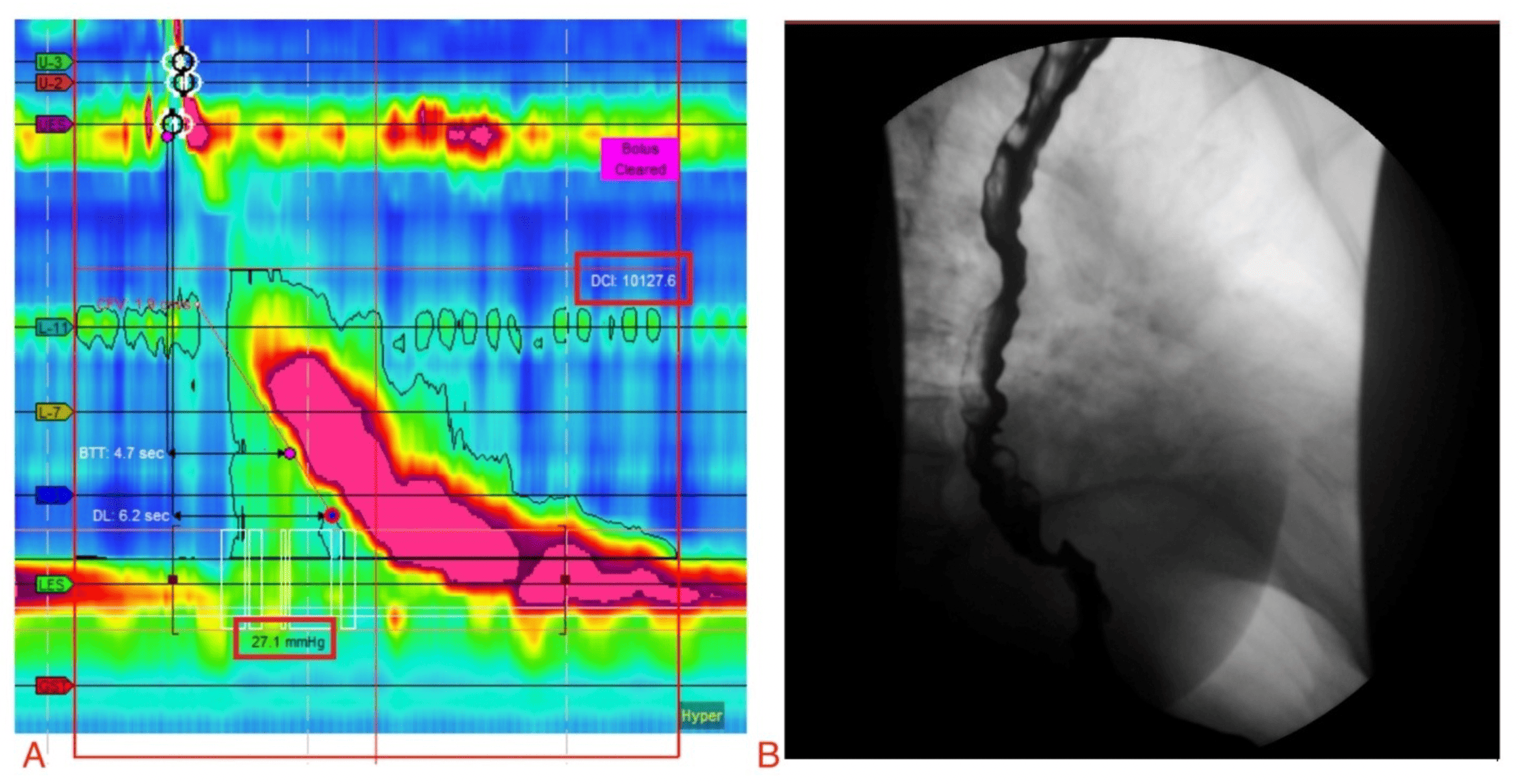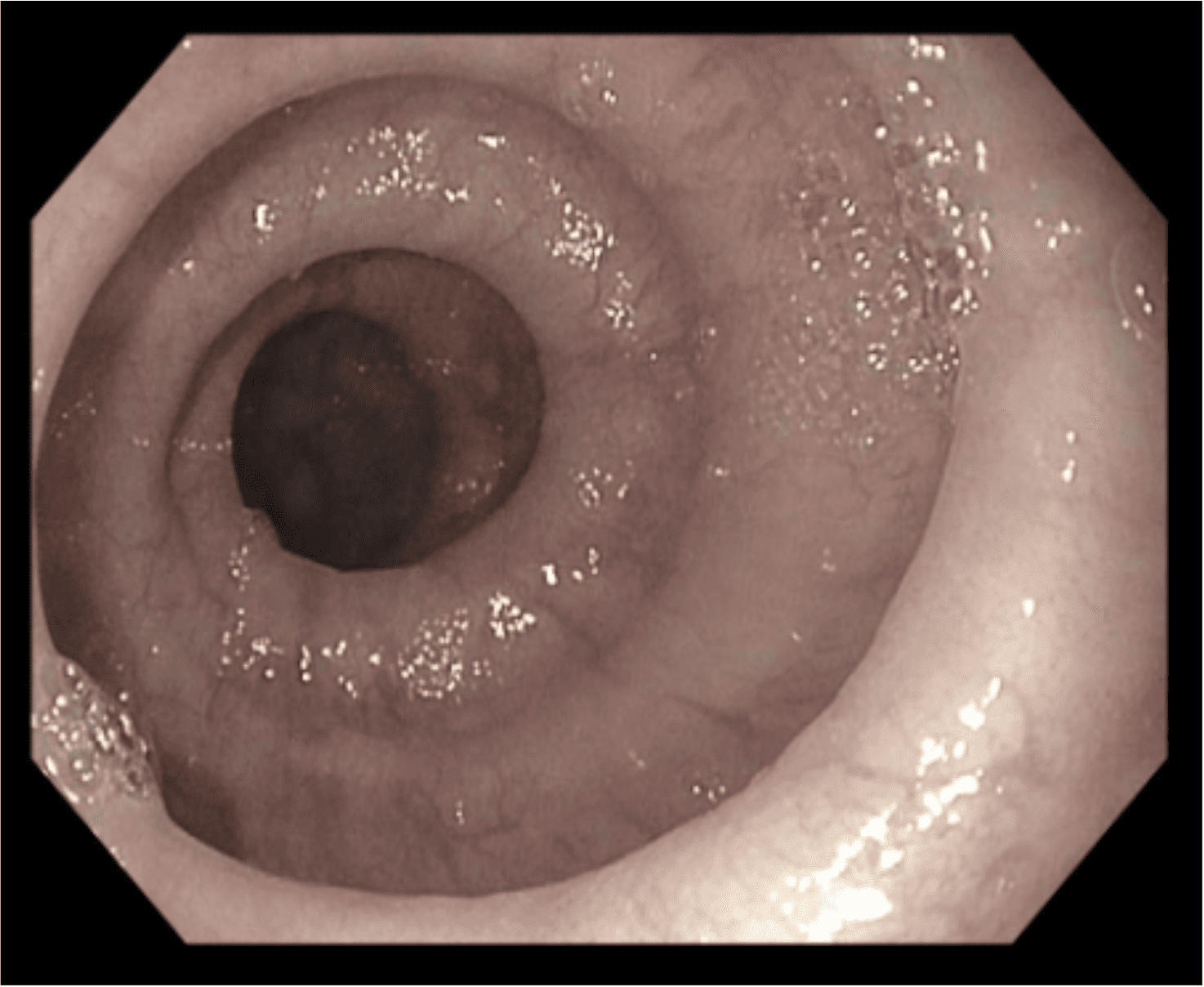Tuesday Poster Session
Category: Esophagus
P4989 - Where the Jackhammer Meets the Corkscrew: A Case of Manometric Hypercontractile Esophagus and Esophagogastric Junction Outflow Obstruction With Endoscopic Features of Distal Esophageal Spasm
Tuesday, October 28, 2025
10:30 AM - 4:00 PM PDT
Location: Exhibit Hall

Nihal Ijaz I. Khan, MD
AdventHealth Orlando
Orlando, FL
Presenting Author(s)
Nihal I. Khan, MD1, Ernesto Robalino. Gonzaga, MD2, Mariam Naveed, MD3, Irteza Inayat, MD3
1AdventHealth Orlando, Orlando, FL; 2Department of Gastroenterology and Hepatology, AdventHealth Orlando, Orlando, FL; 3Department of Gastroenterology and Hepatology, Adventhealth Orlando, Orlando, FL
Introduction: Esophageal peristaltic disorders with normal esophagogastric junction (EGJ) relaxation, as defined by the Chicago Classification v4.0, include hypercontractile (Jackhammer esophagus, HE) and distal esophageal spasm (DES). These are distinguished by the presence of ≥20% hypercontractile (HE) versus premature (DES) swallows. Esophagogastric junction outflow obstruction (EGJOO) is characterized by preserved peristalsis but impaired lower esophageal sphincter (LES) relaxation. We present a unique case of HE with concomitant EGJOO on high-resolution manometry (HRM), exhibiting endoscopic features typical of DES.
Case Description/
Methods: A 70-year-old female with a history of Parkinson’s disease and diabetes mellitus presented with a three-month history of intermittent solid food dysphagia and heartburn. Initial barium esophagram revealed tertiary contractions in the mid to distal esophagus (Figure 1A). Esophagogastroduodenoscopy (EGD) with pH monitoring showed no structural abnormalities and acid exposure was not correlated with symptoms. A subsequent EGD with HRM revealed elevated LES pressures, 40% hypercontractile swallows, and abnormal LES relaxation (Figure 1B).
To further evaluate her esophageal dysmotility, a repeat EGD with Endoflip panometry was performed, demonstrating esophageal spasticity and multiple extra peristaltic contractions producing a classic “corkscrew” (Figure 2). The patient was diagnosed with HE with EGJOO and initiated on calcium channel blockers. She was referred for per-oral endoscopic myotomy (POEM) for further management.
Discussion: Esophageal motility disorders often present with overlapping symptoms including chest pain, regurgitation and dysphagia. While DES typically produces a “corkscrew” appearance on both barium esophagram and EGD, these findings are uncommon in HE. Interestingly, our patient’s barium study was non-specific, but endoscopic imaging revealed a striking corkscrew morphology, more characteristic of DES. HE with EGJOO is increasingly recognized as a distinct but rare manometric pattern with an unclear pathophysiologic basis. HRM and EndoFLIP remain essential tools in confirming diagnosis and guiding therapy. This case highlights the diagnostic complexity and clinical overlap between HE, DES and EGJOO, emphasizing the importance of integrating clinical, endoscopic, and manometric findings to tailor management effectively.

Figure: Figure 1. A: HRM mean composites of 10 swallows showing hypercontractile swallows and elevated LES pressures B: Barium esophagram showing moderate tertiary contractions of the mid to distal esophagus

Figure: Figure 2. Endoscopic image of the distal esophagus showing spastic contractions in a characteristic ‘corkscrew’ pattern
Disclosures:
Nihal Khan indicated no relevant financial relationships.
Ernesto Gonzaga indicated no relevant financial relationships.
Mariam Naveed indicated no relevant financial relationships.
Irteza Inayat indicated no relevant financial relationships.
Nihal I. Khan, MD1, Ernesto Robalino. Gonzaga, MD2, Mariam Naveed, MD3, Irteza Inayat, MD3. P4989 - Where the Jackhammer Meets the Corkscrew: A Case of Manometric Hypercontractile Esophagus and Esophagogastric Junction Outflow Obstruction With Endoscopic Features of Distal Esophageal Spasm, ACG 2025 Annual Scientific Meeting Abstracts. Phoenix, AZ: American College of Gastroenterology.
1AdventHealth Orlando, Orlando, FL; 2Department of Gastroenterology and Hepatology, AdventHealth Orlando, Orlando, FL; 3Department of Gastroenterology and Hepatology, Adventhealth Orlando, Orlando, FL
Introduction: Esophageal peristaltic disorders with normal esophagogastric junction (EGJ) relaxation, as defined by the Chicago Classification v4.0, include hypercontractile (Jackhammer esophagus, HE) and distal esophageal spasm (DES). These are distinguished by the presence of ≥20% hypercontractile (HE) versus premature (DES) swallows. Esophagogastric junction outflow obstruction (EGJOO) is characterized by preserved peristalsis but impaired lower esophageal sphincter (LES) relaxation. We present a unique case of HE with concomitant EGJOO on high-resolution manometry (HRM), exhibiting endoscopic features typical of DES.
Case Description/
Methods: A 70-year-old female with a history of Parkinson’s disease and diabetes mellitus presented with a three-month history of intermittent solid food dysphagia and heartburn. Initial barium esophagram revealed tertiary contractions in the mid to distal esophagus (Figure 1A). Esophagogastroduodenoscopy (EGD) with pH monitoring showed no structural abnormalities and acid exposure was not correlated with symptoms. A subsequent EGD with HRM revealed elevated LES pressures, 40% hypercontractile swallows, and abnormal LES relaxation (Figure 1B).
To further evaluate her esophageal dysmotility, a repeat EGD with Endoflip panometry was performed, demonstrating esophageal spasticity and multiple extra peristaltic contractions producing a classic “corkscrew” (Figure 2). The patient was diagnosed with HE with EGJOO and initiated on calcium channel blockers. She was referred for per-oral endoscopic myotomy (POEM) for further management.
Discussion: Esophageal motility disorders often present with overlapping symptoms including chest pain, regurgitation and dysphagia. While DES typically produces a “corkscrew” appearance on both barium esophagram and EGD, these findings are uncommon in HE. Interestingly, our patient’s barium study was non-specific, but endoscopic imaging revealed a striking corkscrew morphology, more characteristic of DES. HE with EGJOO is increasingly recognized as a distinct but rare manometric pattern with an unclear pathophysiologic basis. HRM and EndoFLIP remain essential tools in confirming diagnosis and guiding therapy. This case highlights the diagnostic complexity and clinical overlap between HE, DES and EGJOO, emphasizing the importance of integrating clinical, endoscopic, and manometric findings to tailor management effectively.

Figure: Figure 1. A: HRM mean composites of 10 swallows showing hypercontractile swallows and elevated LES pressures B: Barium esophagram showing moderate tertiary contractions of the mid to distal esophagus

Figure: Figure 2. Endoscopic image of the distal esophagus showing spastic contractions in a characteristic ‘corkscrew’ pattern
Disclosures:
Nihal Khan indicated no relevant financial relationships.
Ernesto Gonzaga indicated no relevant financial relationships.
Mariam Naveed indicated no relevant financial relationships.
Irteza Inayat indicated no relevant financial relationships.
Nihal I. Khan, MD1, Ernesto Robalino. Gonzaga, MD2, Mariam Naveed, MD3, Irteza Inayat, MD3. P4989 - Where the Jackhammer Meets the Corkscrew: A Case of Manometric Hypercontractile Esophagus and Esophagogastric Junction Outflow Obstruction With Endoscopic Features of Distal Esophageal Spasm, ACG 2025 Annual Scientific Meeting Abstracts. Phoenix, AZ: American College of Gastroenterology.
